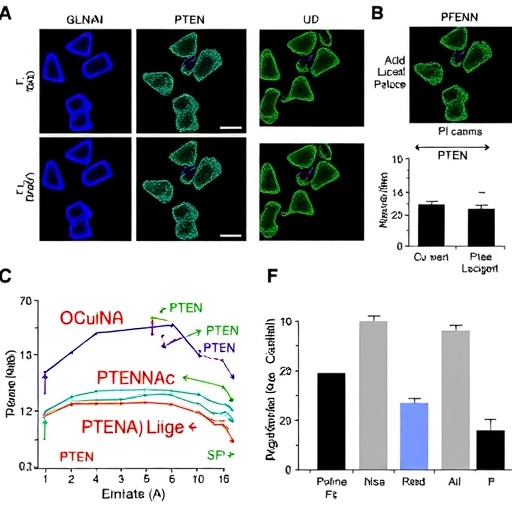
Credit: Charity Owings, School of Science, Indiana University-Purdue University Indianapolis
INDIANAPOLIS — Researchers at the School of Science at Indiana University-Purdue University Indianapolis have sequenced the genome of the black blow fly, an insect commonly found throughout the United States, southern Canada and parts of northern Europe.
Black blow flies have environmental, medical and forensic uses, functioning as nature's recyclers, as wound cleansers and as forensic timekeepers. They have a blue or green sheen and are similar in size to common houseflies.
The female genome was found to contain 8,312 genes; the male genome had 9,490 genes.
"There is nothing special about black blow flies (scientific name Phormia regina), but that lack of uniqueness is why scientists are interested in studying them," said Christine Picard, assistant professor of biology and forensic scientist, who led the team that sequenced the genome.
Picard offers the following analogy to explain her research interest in black blow flies: "If you are interested in studying a particular human disease, for instance, you don't start by studying people with the disease. You start by studying healthy individuals, and then you look for differences between the healthy and the sick to make sure any differences that you observe are actually due to the disease and not due to other factors.
"The first step is to figure out what the normal is. That's why I have been studying this fly for a decade and we have been working on sequencing its genome for the past five years: because this is an essentially unremarkable insect. It doesn't do anything that is abnormal. Having sequenced the black blow fly genome, we are providing a major resource for all of the researchers who are studying other insects that have unusual or dangerous characteristics, such as a species of fly that fatally attacks livestock."
Black blow flies are active insects that perform three tasks that benefit humans: recycling carrion, debriding human wounds and laying eggs on freshly dead bodies. They have no harmful or parasitic behaviors.
Black blow flies feed on decaying flesh and help consume dead vertebrates throughout the environment. Black blow fly larvae, or maggots, are used medically to debride human wounds, as the insects physically remove dead tissue while simultaneously excreting antimicrobial compounds into the wound. With an excellent sense for smelling recently dead tissue, black blow flies are usually the first insects to colonize a human body, frequently within minutes after death. Females lay eggs on recently deceased corpses, setting a "clock" that enables forensic investigators to estimate the postmortem interval, or minimum time since death.
Other gene-mapping projects have been conducted by large, often international consortiums, with one group working on one aspect and others on different aspects, as a collaborative project. IUPUI's black blow fly genome sequencing was primarily conducted over four years by biology doctoral candidate Anne Andere under Picard's mentorship, with input from Texas Tech University biologists R.N. Platt II and David A. Ray.
"Genome sequence of Phormia regina Meigen (Diptera: Calliphoridae): Implications for medical, veterinary and forensic research" is published online in BMC Genomics. Graduate student Andere is the first author. Picard, the corresponding author, is assistant professor in the Department of Biology and the Forensic and Investigative Sciences Program. She works at the interface of forensic entomology and molecular biology.
Insects constitute slightly more than half of all living species on Earth. In 2011, i5K, an initiative to sequence the genomes of 5,000 insects and other arthropods within five years, was launched. Thus far, however, only 239 arthropod genomes have been sequenced, with now the black blow fly genome available.
"Now that we have described the genome," said Picard, "I plan to continue working toward a better understanding of black blow fly population variation from location to location, and show how the variations influence postmortem interval estimates, with the goal of making these important determinations more accurate."
Picard said the mapping of the black blow fly genome will also help researchers gain better insight into insecticide sensitivity and resistance. Knowledge of the genome will advance understanding of the antimicrobial compounds secreted by these specific insects as well.
The black blow fly gene-mapping results completed at IUPUI have been deposited with the National Center for Biotechnology Information's Sequence Read Archive Database and are accessible to researchers around the world.
###
Financial support for the sequencing of the black blow fly genome was received from the Department of Biology and the School of Science at IUPUI and the National Science Foundation grants for supercomputing and data analysis awarded to Indiana University and the National Center for Genome Analysis Support, grants DBI-1458641 and ABI-1062432.
The School of Science at IUPUI is committed to excellence in teaching, research and service in the biological, physical, behavioral and mathematical sciences. The School is dedicated to being a leading resource for interdisciplinary research and science education in support of Indiana's effort to expand and diversify its economy.
Media Contact
Cindy Fox Aisen
[email protected]
317-843-2275
http://science.iupui.edu/





